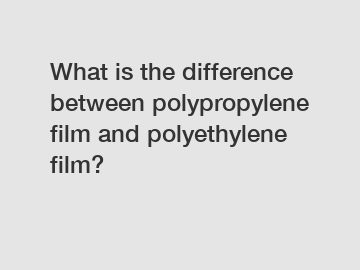What is the difference between polypropylene film and polyethylene film?
If you work in the packaging industry, chances are you've come across the terms polypropylene film and polyethylene film. These two materials are commonly used in the manufacturing of various types of packaging, but what exactly sets them apart? In this blog post, we will delve into the key differences between polypropylene film and polyethylene film to help you better understand which one might be more suitable for your packaging needs.
First and foremost, let's talk about what polypropylene film and polyethylene film are. Both are types of thermoplastic polymers that are used to create flexible packaging materials. However, they have different properties that make them suitable for different applications.
Polyethylene film, also known as PE film, is made from a polymer that is derived from ethylene gas. It is known for its flexibility and toughness, making it ideal for applications where puncture resistance is important. PE film is commonly used in food packaging, medical packaging, and industrial packaging due to its strength and durability.

On the other hand, polypropylene film, also known as PP film, is made from a polymer that is derived from propylene gas. It is widely used in the packaging industry due to its excellent clarity, moisture resistance, and heat-sealing properties. PP film is commonly used in food packaging, gift wrapping, and labeling applications due to its high transparency and printability.
One of the key differences between polypropylene film and polyethylene film lies in their physical properties. Polyethylene film is known for its high tensile strength and puncture resistance, making it suitable for heavy-duty applications where durability is key. On the other hand, polypropylene film is known for its high clarity and excellent sealability, making it ideal for applications where product visibility and presentation are important.
Another important difference between polypropylene film and polyethylene film is their heat-sealing properties. Polyethylene film has a lower melting point than polypropylene film, which means it requires less heat to seal. This makes it easier to work with and more cost-effective for high-speed packaging applications. Polypropylene film, on the other hand, has a higher melting point, which allows for stronger seals and better moisture resistance.
In terms of cost, polyethylene film is generally more affordable than polypropylene film. This makes it a popular choice for budget-conscious customers who still require a durable and reliable packaging solution. Polypropylene film, on the other hand, offers higher quality and better performance, but at a higher price point. It is often used in premium packaging applications where appearance and performance are of utmost importance.
When it comes to recyclability, both polypropylene film and polyethylene film are 100% recyclable. However, polyethylene film is more commonly recycled due to its widespread use in consumer packaging. Polypropylene film is also recyclable, but it is less commonly accepted by recycling facilities due to its lower melting point and different chemical composition.
In conclusion, both polypropylene film and polyethylene film have their own unique properties and advantages. Polyethylene film is known for its strength and durability, while polypropylene film is prized for its clarity and sealability. When choosing between the two, it's important to consider your specific packaging needs and budget to determine which material is the best fit for your application.
Regardless of which material you choose, both polypropylene film and polyethylene film are versatile and reliable packaging solutions that can help you protect and showcase your products effectively. By understanding the differences between these two materials, you can make an informed decision that will help you create packaging that meets your needs and exceeds your expectations.
Want more information on Esd Pe Ziplock Bag, ESD-safe bags for comprehensive protection, Epe Foam Bag? Feel free to contact us.


